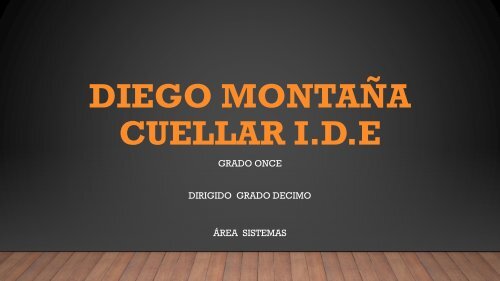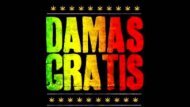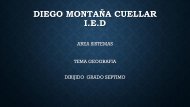INGLES DECIMO GRADO
Create successful ePaper yourself
Turn your PDF publications into a flip-book with our unique Google optimized e-Paper software.
DIEGO MONTAÑA<br />
CUELLAR I.D.E<br />
<strong>GRADO</strong> ONCE<br />
DIRIGIDO <strong>GRADO</strong> <strong>DECIMO</strong><br />
ÁREA SISTEMAS
TABLA DE CONTENIDOS<br />
• 1.CUANTIFICADORES SUSTAN<br />
TIVOS CONTABLES Y NO<br />
CONTABLES.<br />
• PRESENTE PERFECTO<br />
• Cuales son los sustantivos<br />
contables y no contables<br />
• Que son cuantificadores
OBJETIVO<br />
DAR<br />
A CONOCER LOS TEMAS DE <strong>GRADO</strong> <strong>DECIMO</strong> DE MODO QUE LOS<br />
ESTUDIANTES LOS IDENTIFIQUEN
CUANTIFICADORES - SUSTANTIVOS CONTABLES<br />
Y NO CONTABLES.<br />
• Cuales son los sustantivos<br />
contables y no contables:<br />
Los nombres se usan para referirse<br />
a personas, animales, cosas y<br />
objetos, eventos, lugares o ideas<br />
abstractas. Como hemos visto en la<br />
lección sobre los artículos, los<br />
nombres no tienen género.<br />
Cuales son los no contables<br />
Los sustantivos incontables son<br />
aquellos que no se pueden contar<br />
individualmente ya sea debido a su<br />
naturaleza o a lo inconmensurable<br />
de su cantidad. Ejemplo es el harina,<br />
no se puede hablar de ella si no es<br />
basándose en medidas, llamadas<br />
unidades.
QUE SON LOS CUANTIFICADORES<br />
• Los cuantificadores indican la<br />
cantidad de un nombre. Son<br />
repuestas a la pregunta “¿Cuántos?”.<br />
Al igual que los artículos, los<br />
cuantificadores definen a un nombre<br />
y siempre están situados delante del<br />
nombre. Algunos se pueden usar<br />
sólo con nombres contables, otros,<br />
sólo con nombres incontables y<br />
otros, con ambos.<br />
• Many<br />
• Significado: Mucho<br />
Uso: Expresa la idea de gran<br />
cantidad<br />
Ejemplos:<br />
Frase negativa:<br />
Frase interrogativa:<br />
• There are not many tourists. (No hay<br />
muchos turistas.)<br />
• How many cats do you have? (¿Cuántos gatos<br />
tienes?)
MUCH<br />
• Significado: Mucho<br />
Uso: Como “many”, expresa la<br />
idea de gran cantidad y es<br />
utilizado sobretodo en frases<br />
negativas
• Significado: Algunos, unos<br />
Uso: Se utiliza tanto para los<br />
nombres o sustantivos incontables<br />
como para los nombres o sustantivos<br />
contables en plural. Se usa en frases<br />
afirmativas e interrogativas (para<br />
afirmar algo); se sustituye “any” en<br />
frases negativas o interrogativas.<br />
Significa una cantidad indefinida,<br />
pero limitada<br />
SOME
ANY<br />
• Significa algunos o algunas, lo<br />
utilizamos cuando nosotros<br />
preguntamos acerca de algo o<br />
números de cosas de las que no<br />
conocemos la cantidad exacta,<br />
Any también es usado en frases<br />
negativas
ACTIVIDADA<br />
• REALIZAR 5 ORACIONES CON<br />
CADA CUANTIFICADOR<br />
• A) much<br />
• B) many<br />
• C) some<br />
• D) any
A) Much<br />
He has much money to lend<br />
El tiene mucho dinero para dar<br />
We have much to sell<br />
Nosotros tenemos mucho para<br />
vender<br />
I have much to give<br />
Yo tengo mucho por dar<br />
SOLUCIÓN<br />
Much para frases negativas:<br />
We do not have much time for fun<br />
Nosotros no tenemos mucho tiempo<br />
para divertirnos<br />
She does not have much energy<br />
to this work<br />
Ella no tiene mucha energia para<br />
trabajar<br />
I have not much water to drink<br />
Yo no tengo mucha agua para tomar
• B) MANY :<br />
-We have many dollars in the bank<br />
Nosotros tenemos muchos dolares en el banco<br />
-Mary has many dogs at home<br />
Mary tiene muchos perros en casa<br />
-They have many houses in the city<br />
Ellos tienen muchas casas en la ciudad<br />
• Many para Frases negativas:<br />
-There are not many books in the school<br />
No hay muchos libros en la escuela<br />
-There are not many computers for the<br />
work<br />
-No hay muchas computadoras para el<br />
trabajo
PRESENTE PERFECTO<br />
• El Presente Perfecto en el idioma<br />
inglés es un tiempo verbal que se<br />
utiliza para referirnos a acciones<br />
que suceden en un pasado y que<br />
guardan alguna relación con<br />
el presente. Su equivalente en el<br />
idioma español es el Pretérito<br />
Perfecto<br />
EJEMPLO:<br />
° I have sent the letter.<br />
Yo he enviado la carta.<br />
Para poder construir la forma<br />
afirmativa del Presente Perfecto<br />
debemos utilizar como auxiliar el<br />
verbo TO HAVE en Presente Simple y<br />
acompañado por el verbo principal en<br />
su Pasado Participio (ya sean VERVOS<br />
REGULARES o VERVOS<br />
IRREGULARES):
Para poder construir la forma<br />
afirmativa del Presente<br />
Perfecto debemos utilizar como<br />
auxiliar el<br />
verbo TO HAVE en Presente<br />
Simple y acompañado por el<br />
verbo principal en su Pasado<br />
Participio (ya sean VERVOS<br />
REGULARES o VERVOS<br />
IRREGULARES):<br />
• have bought a new dress.<br />
Yo he comprado un nuevo vestido.<br />
• You have studied the lesson.<br />
Tú has estudiado la lección.<br />
• He has broken the window.<br />
Él ha roto la ventana.<br />
• She has lost the keys.<br />
Ella ha perdido las llaves.
• En cambio, para formar<br />
una interrogación deberemos<br />
colocar el auxiliar al comienzo de<br />
la oración, luego el sujeto y<br />
posteriormente el verbo principal<br />
también en Pasado Participio<br />
• Have I bought a new dress?<br />
He comprado un nuevo vestido?<br />
• Have you studied the lesson?<br />
Has estudiado la lección?<br />
• Has he broken the window?<br />
Ha roto él la ventana?<br />
• Has she lost the keys?<br />
Ha perdido ella las llaves?
ambién puede utilizarse la forma<br />
contraída de la negación<br />
colocando<br />
HAVEN’T o HASN’T según<br />
corresponda.<br />
Cabe destacar que cuando<br />
hablamos en Presente<br />
Perfecto no debemos mencionar<br />
el momento en que se ha<br />
producido la acción, ya que de<br />
hacerlo deberíamos utilizar<br />
el PASADO SIMPLE<br />
por ejemplo:<br />
I have sold my car.<br />
Yo he vendido mi<br />
auto. (Presente Perfecto)<br />
I sold my car this morning.<br />
Yo vendí mi auto esta mañana.<br />
(Pasado Simple
Significado de to have<br />
Significados:<br />
1- El verbo "to have" significa haber o tener<br />
I have a car<br />
yo tengo un coche<br />
2.- To have es uno de los verbos auxiliares en inglés<br />
junto con to Do ,TO BE y will. Cuando "To have"<br />
funciona con el rol de verbo auxiliar carece de<br />
significado.
C) SOME:<br />
-There is some sugar in the basket<br />
Hay algo de azucar en la canasta<br />
-There are some people in the park<br />
Hay algo de gente en el parque<br />
-There are some problems with the<br />
work<br />
Hay algunos problemas con el<br />
trabajao<br />
Some para frases interrogativas:<br />
-Do you want some money?<br />
¿Quieres algo de dinero?<br />
-Do you have some time for me?<br />
¿Tienes algo de tiempo para mi?
• D) ANY<br />
• There don't have any eggs<br />
Ellos no tienen ningún huevo<br />
• I don't have any money<br />
No tengo nada de dinero<br />
• Any para frases interrogativas:<br />
• Is there any bread?<br />
¿Hay algo de pan?<br />
• There are not any people in the<br />
park<br />
No hay ninguna persona en el<br />
parque<br />
° Are There any dogs in the park?<br />
¿Hay algunos perros en el parque
BIBLIOGRAFIA<br />
• http://blogpara-aprenderingles.blogspot.com.co/2012/08/cuantificadoresen-ingles-y-sus-ejemplos.html<br />
• http://jorgepereztapia.blogspot.com.co/2015/06/guia-de-trabajo-paradecimo-grado-10.html
CRISTIAN ALFREDO CRUZ<br />
YATE<br />
11-02













